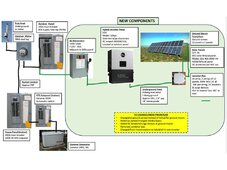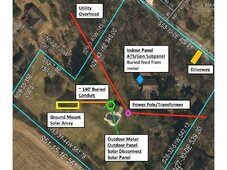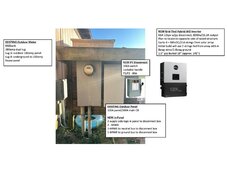DaveNSueM
New Member
Evening all - first post...awesome info here, have not been able to stop reading for past 2 days.
I have planned a 8KW solar (only covers about 40% of annual usage - may expand panel count in future) install (ground mount) using microinverters, grid tied, line side taps, AC fused disconnect...have received permits and interconnect agreement with my Ohio power company. I have a 2 year old generac NG generator feeding critical loads so no need for the system to handle any backup loads.
Talking to a friend recently they mentioned planning for future when net metering phases out and having battery capability to store excess solar for nightime use...seems to make sense and I like to plan ahead when possible. This line of thinking leads me to believe I may pay a premium for the micro's, which also have a proprietary battery system and not nearly the other features of some of the hybrid systems I have been reading about.
I want to start with panels/grid tied inverter only and add battery maybe in a year or so. Seems like so many options to choose from if I go string/hybrid...right now the EG4 18kpv has caught my eye BUT I have seen a few posts where it is mentioned that it may have issues if only setup as grid tied with no battery...is this still true or has EG4 resolved (I will email them directly). Any other systems that could fit this use case? Thanks in advance for any help.
I have planned a 8KW solar (only covers about 40% of annual usage - may expand panel count in future) install (ground mount) using microinverters, grid tied, line side taps, AC fused disconnect...have received permits and interconnect agreement with my Ohio power company. I have a 2 year old generac NG generator feeding critical loads so no need for the system to handle any backup loads.
Talking to a friend recently they mentioned planning for future when net metering phases out and having battery capability to store excess solar for nightime use...seems to make sense and I like to plan ahead when possible. This line of thinking leads me to believe I may pay a premium for the micro's, which also have a proprietary battery system and not nearly the other features of some of the hybrid systems I have been reading about.
I want to start with panels/grid tied inverter only and add battery maybe in a year or so. Seems like so many options to choose from if I go string/hybrid...right now the EG4 18kpv has caught my eye BUT I have seen a few posts where it is mentioned that it may have issues if only setup as grid tied with no battery...is this still true or has EG4 resolved (I will email them directly). Any other systems that could fit this use case? Thanks in advance for any help.







